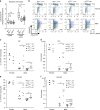Identification of a genomic enhancer that enforces proper apoptosis induction in thymic negative selection
- PMID: 31197149
- PMCID: PMC6565714
- DOI: 10.1038/s41467-019-10525-1
Identification of a genomic enhancer that enforces proper apoptosis induction in thymic negative selection
Abstract
During thymic negative selection, autoreactive thymocytes carrying T cell receptor (TCR) with overtly strong affinity to self-MHC/self-peptide are removed by Bim-dependent apoptosis, but how Bim is specifically regulated to link TCR activation and apoptosis induction is unclear. Here we identify a murine T cell-specific genomic enhancer EBAB (Bub1-Acoxl-Bim), whose deletion leads to accumulation of thymocytes expressing high affinity TCRs. Consistently, EBAB knockout mice have defective negative selection and fail to delete autoreactive thymocytes in various settings, with this defect accompanied by reduced Bim expression and apoptosis induction. By contrast, EBAB is dispensable for maintaining peripheral T cell homeostasis via Bim-dependent pathways. Our data thus implicate EBAB as an important, developmental stage-specific regulator of Bim expression and apoptosis induction to enforce thymic negative selection and suppress autoimmunity. Our study unravels a part of genomic enhancer codes that underlie complex and context-dependent gene regulation in TCR signaling.
Conflict of interest statement
The authors declare no competing interests.
Figures









References
Publication types
MeSH terms
Substances
Grants and funding
- 15H01478/MEXT | Japan Society for the Promotion of Science (JSPS)/International
- 18K15409/MEXT | Japan Society for the Promotion of Science (JSPS)/International
- 18H04810: S.K/MEXT | Japan Society for the Promotion of Science (JSPS)/International
- na/Uehara Memorial Foundation/International
- na/Japan Foundation for Applied Enzymology/International
LinkOut - more resources
Full Text Sources
Other Literature Sources
Molecular Biology Databases
Research Materials

